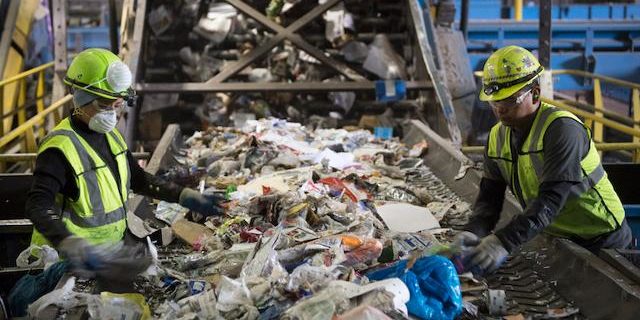When I first started to compost my biodegradable waste, I had a pot with earthworms and indiscriminately put everything I generated into it. Very soon, the little fellows began to die and baby cockroaches started to take over. Between cockroaches and maggots, the composting was happening very quickly, but there was a high chance that the insects would start to colonise my home, so I went back to learning about the composting process.
 Along the way, I also learnt that a simple segregation of wet/dry waste was insufficient. I saw the men on the garbage truck quickly sorting the garbage and scavenging the useful materials. I couldn’t help the fact that they were working in horrifying conditions, next to rotting piles of waste. But I could help them find the few useful pieces faster (and prevent them from getting unnecessary cuts and bruises).
Along the way, I also learnt that a simple segregation of wet/dry waste was insufficient. I saw the men on the garbage truck quickly sorting the garbage and scavenging the useful materials. I couldn’t help the fact that they were working in horrifying conditions, next to rotting piles of waste. But I could help them find the few useful pieces faster (and prevent them from getting unnecessary cuts and bruises).
1. Wet Waste –Vegetable peels and kitchen scraps are a lot easier to dispose than cooked food. Even the head of a pineapple can be buried to generate a new plant, but leftovers from yesterday’s delicious biriyani attract pests and set up undesirable ecosystems (like the one bringing leopards into slums in Mumbai). Indoor, anaerobic composting pots are a good option if you want to dump all the wet waste in one spot. If you like the smell of petrichor in a pot, though, you can try vermicomposting just the green leafy parts of your kitchen waste. (P.S. Apparently earthworms love a bit of tea with their breakfast. Adding some used tea leaves along with cucumber peels seems to be helping them).
2. Paper – Most cities have a simple and fairly efficient system for recycling newsprint.  Many recyclers are willing to accept scrap paper as well. If you want to engage your kid during long summer holidays, they can remove the unused paper from their notebooks and make a fresh scrapbook for the next year. For some inspiration, check out the work of the Tzu Chi Recycling Centre in many parts of Asia.
Many recyclers are willing to accept scrap paper as well. If you want to engage your kid during long summer holidays, they can remove the unused paper from their notebooks and make a fresh scrapbook for the next year. For some inspiration, check out the work of the Tzu Chi Recycling Centre in many parts of Asia.
3. Plastic – Nearly every large city has a few entrepreneurs who pick up plastic waste and generate income from recycling. Look for them and ask if they will set up a collection schedule for your apartment. A large number of companies are waking up to the economic advantage of using recycled products. Some innovators like Rajagopalan Vasudevan are finding ways to use the plastic before it reaches a landfill. There is no real way to combat the plastic problem than be drastically reducing and repeatedly refusing plastic bags and packaging. Until then, though, segregating your waste is a good start.
4. Electronics – Cell phones, laptops, and a number of other personal devices are constantly being upgraded. There is usually a sad drawer or shelf in every home with old chargers, wires, and defunct electronics. Some local municipalities have collection points for electronic waste. Take advantage of these facilities. 
5. Hazardous Waste – Material contaminated by human medical waste (diapers, sanitary pads, blades, needles, syringes, swabs), or those with toxic chemicals (batteries) need to be disposed separately. If you have an elderly person or a young baby at home, and regularly use diapers, cover them in paper, and throw them separately, with a clearly marked ‘X’ in red (or consider switching to cloth). Wrap blades, needles, and broken glass in cloth or paper so that the conservancy worker doesn’t hurt herself.
When I first saw Bangalore Municipal Corporation’s directive for segregating waste, I was overwhelmed. It seemed like I needed to understand and assimilate a lot of information (and find 3-4 new waste bins). If this is a lot to process, start small and simply segregate wet and dry waste. If the garbage came from a plant (with roots) or animal, try to compost it. If it was born in a different kind of plant (with synthetic chemicals), place it in a separate bin!







